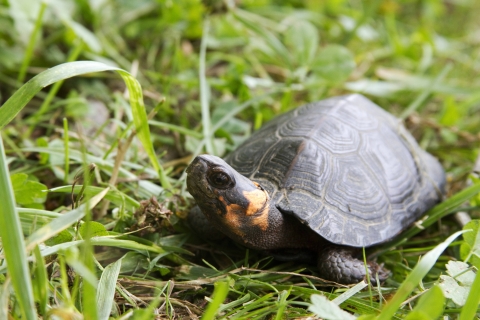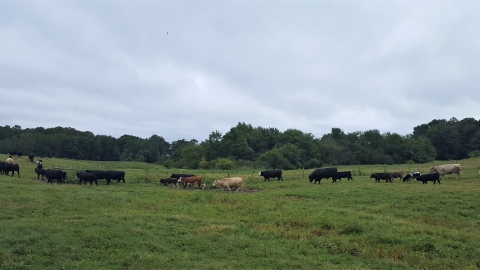In an area as big as the Delaware River watershed — which encompasses nearly 14,000 square miles in parts of Delaware, New Jersey, New York, and Pennsylvania — conservation projects that cover a few dozen acres may seem like a drop in the bucket if your goal is to sustain natural resources for current and future generations.
But even small projects can have a big conservation impact when they are connected to each other through a shared vision. The resulting benefits don’t just pool in one place; they spread, like ripples moving across the surface of the water.
Just ask North America's smallest turtle. Topping out at 4.5 inches long — about the size of a smartphone — the bog turtle is one of the priority species that drives strategic investments in the watershed through the U.S. Fish and Wildlife Service’s Delaware Watershed Conservation Fund.
Small but mighty
Motivated by this small turtle, which is listed as threatened in the northern part of its range under the Endangered Species Act, agricultural landowners in New Jersey are changing management practices on their lands.
The ripple effects? Farmers aren’t just adopting new practices because it’s good for the bog turtle; it’s also good for business, which contributes to the economic vitality of the region.
And those practices, like rotational grazing, reduce soil erosion, which improves water quality — a plus for all watershed residents.
“We start by addressing the resource challenge the farmer is facing, and then we look for a wildlife nexus,” said John Cecil, former Vice President for Stewardship for New Jersey Audubon, the grantee that is leading the project to restore and connect bog turtle habitat in the Upper Salem River Watershed.
“That’s the sweet spot for the Delaware Watershed Conservation Fund,” Cecil said. “Because it lies at the intersection of water, habit conservation, and recreation, it helps us leverage water-quality work to address needs for wildlife as well.”
Launched in 2018, the Service's Delaware Watershed Conservation Fund has awarded more than $40 million to date to projects that support recreation, water quality, water management and habitat, or a combination of these things like New Jersey Audubon's bog turtle work. A historic investment from the Bipartisan Infrastructure Law Bipartisan Infrastructure Law
The Bipartisan Infrastructure Law (BIL) is a once-in-a-generation investment in the nation’s infrastructure and economic competitiveness. We were directly appropriated $455 million over five years in BIL funds for programs related to the President’s America the Beautiful initiative.
Learn more about Bipartisan Infrastructure Law in 2021 provided $26 million to deploy through the fund over the next five years to accelerate collaborative efforts to sustain the watershed's resources through innovation in green-infrastructure and initiatives that focus on the health and economic vitality of communities.
Farm share
As part of the bog turtle project, which received grants in 2018 and 2021 totaling $142,462, New Jersey Audubon has conducted outreach to landowners in areas identified as potential bog-turtle habitat, and in areas that connect pieces of potential bog-turtle habitat together.
But a few farmers came directly to them.
Through a cooperative agreement with the Natural Resources Conservation Service, New Jersey Audubon is on call to provide technical assistance to landowners who are interested in learning about on-farm conservation practices, say to improve water quality by reducing erosion. To support this work, the organization can tap into funding sources that focus specifically on water quality.
If the farm lies within a priority area for bog turtle, New Jersey Audubon can also suggest voluntary measures to improve bog-turtle habitat, which they can support through the Delaware Watershed Conservation Fund.
Conversation starter
“For an individual who runs a livestock operation, we may start the conversation by talking about cover crops, or no till,” explained Kristen Meistrell, current Vice President of Stewardship for New Jersey Audubon. “Then we talk about bog turtle.”
It’s a natural segue. It turns out bog turtle and cattle have compatible needs. Livestock need a year-round supply of nutritional forage grasses and legumes. Bog turtles need open wet meadows, fed by ground water. But during the winter when turtles are hibernating, they can share that habitat with cattle.
“The goal is to keep bog-turtle habitat open using the right management techniques at the right time, not all the time,” Meistrell explained.
When the ground is frozen —or just less wet — farmers can graze their cattle in the wetland areas. That can benefit turtles by helping to keep the vegetation open. As spring approaches, farmers simply rotate their livestock to a different pasture before the turtles wake up and start looking for mates.
“It works out well for the landowner because it helps them maintain better pasture conditions and better forage for the animals,” Meistrell said, adding, “They also don’t have to deal with livestock getting stuck in the mud.”
Opening doors
Implementing a rotational grazing system requires investment in new infrastructure, like fencing, which New Jersey Audubon supports through the grant. The U.S. Fish and Wildlife Service has also partnered on the project to help navigate the permitting required for working in wetlands, and with a federally listed species.
Although bog turtle may not be the main motivation for landowners to participate in the program, Meistrell said they appreciate the significance of being able to provide a home for a rare turtle that few people will ever see.
“It also helps them get past the idea of thinking that having a federally listed species on your property will close doors,” she said. “We want to convey that in this case, it will open doors: You can get work done that benefits you, bog turtle, and water quality.”
Small turtle, big picture
Through the project, now in its second phase, New Jersey Audubon plans to restore and connect 60 acres of wetland habitat while working with 15 private landowners, and to reach 350 private landowners with information about conservation practices to support bog turtle. The effort was born from an existing partnership between New Jersey Audubon and New Jersey Division of Fish and Wildlife to restore active bog-turtle habitat on state land in the Upper Salem River watershed.
“The restoration started in 2015 and evolved over time through a combination of different efforts: invasive-species control, converting former agricultural land to native cover, and restoring the hydrology in old agricultural ditches,” Meistrell said.
Eventually, the partners started to wonder about the big picture.
“We thought, we’re doing great work at this one site, but what does it mean for the population overall?” she said. “We decided it was time to expand and look for connections.”
That happened to be right when the Delaware Watershed Conservation Fund came into being. Meistrell said it was the perfect opportunity to advance their work on this species beyond state land.
“We were able to meld all of the priorities and strategies together into this one project,” she said. “Everything fit together perfectly.”
The project continues to grow in scope and in partners. Leveraging support from the Delaware Watershed Conservation Fund, New Jersey Audubon recently entered a Regional Conservation Partnership Program through the USDA, which provides complementary resources. Now they are helping landowners preserve their land to ensure bog turtle habitat remains habitat in perpetuity.
For more examples of how the Delaware Watershed Conservation Fund is addressing conservation needs, big and small, across the watershed, check out our fiscal year 2022 report to Congress.








